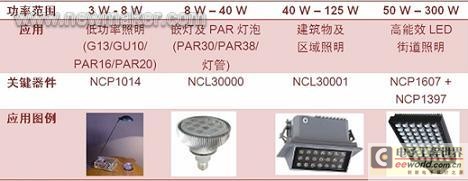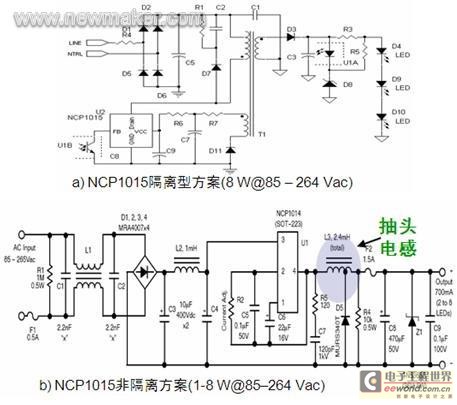In recent years, the market for high-brightness light-emitting diodes (HB-LEDs) has grown rapidly. LED light efficiency continues to increase, and the cost per even of clear light output continues to decline, making its application range wider, in addition to applications such as portable device backlights with less than 4 inches of screen size and large display screens in sports venues. Infiltrating into the market of automobiles, medium and large size liquid crystal display (LCD) backlights and general lighting, the development prospect is very impressive.
Take the general lighting market such as light bulbs and fluorescent tubes, recessed lights, street lights and parking lights, work lights (table lamps, cabinet lighting), landscape lighting, billboard text circuits, building lighting, etc., it is estimated that current LED lighting The proportion of applications (or solid-state lighting, referred to as SSL) is less than 1%. In 2008, the market size (SAM) of LED drivers and related discrete devices was only about 688 million US dollars. It is expected that the market size will increase to 1.308 billion in 2012. The US dollar has a compound annual growth rate of 17.4%. Therefore, LED general lighting has become a hot market.
This article aims to explore the different power ranges and different power supply applications of the LED general lighting market, as well as the applicable LED drivers and related components, to help lighting design engineers choose the right component solutions to speed up the listing process.
Common power application requirements and solutions for different power AC/DC power supply LEDs
Power supply topologies for different power AC-DC LED lighting applications vary. For applications with power below 80W, the flyback topology is the standard choice; in energy-efficient applications, the resonant half-bridge dual inductor plus single capacitor (HB LLC) is preferred. ON Semiconductor offers AC/DC LED lighting solutions covering a wide power range. Table 1 lists several typical ON Semiconductor AC/DC LED lighting solutions.

Table 1: Typical AC/DC LED General Lighting Solutions from ON Semiconductor
From the power rating of the application, AC/DC powered LED general lighting applications include different types of low power, medium power and high power. Low power applications typically range from 1 to 12W, medium power ranges from 8 to 40W, and high power applications often exceed 40W.
1) 1W to 8W LED general lighting application requirements and solutions
Typical applications for low-power LED general illumination from 1W to 8W, such as G13, GU10, PAR16, PAR20 and recessed lights. The input voltage range for this type of application is between 90 and 264V AC. The constant current output current includes 350mA and 700mA. The energy efficiency requirement is 80%, and protection features such as short circuit protection and overvoltage protection are required.
In this type of application, ON Semiconductor's NCP1015 self-powered monolithic switch control IC can be used. The device integrates a fixed frequency (65/100/130kHz) current mode controller and a 700V high voltage MOSFET to provide all the features needed to build a robust, low cost power supply such as soft start, frequency jitter, short circuit protection, skip cycle, maximum Peak current set point and dynamic self-powering function (no auxiliary winding required).
It is worth mentioning that the NCP1015 can be used in both 1W and 8W LED lighting applications for both isolated and non-isolated solutions to meet different application needs of customers. The cost of these two programs is almost the same. However, the isolated solution uses a transformer to achieve electrical isolation. The solution includes a simple feedback circuit and a clamp circuit for load open circuit and fault protection. It has high safety and is more suitable for applications requiring safety certification. The non-isolated solution uses a tapped inductor to isolate the AC signal, improving the duty cycle of the MOSFET operation and improving system efficiency and circuit performance.

Figure 1: 1 to 8W isolated (a) and non-isolated (b) LED lighting solutions based on ON Semiconductor NCP1015
The above NCP1015-based isolated and non-isolated solutions do not contain PFC, but ON Semiconductor also offers PFC-enabled NCP1015/NCP1014 solutions to provide customers with more choices.
2) 8W to 25W LED general lighting application requirements and solutions: no PFC and PFC
In 8 to 25W AC/DC LED lighting applications, we have to consider two situations. One is that the application does not require power factor correction (PFC). On the other hand, the US Department of Energy (DOE) Energy Star Solid State Lighting (SSL) specification requires mandatory power factor correction (PFC) for any power class. This standard applies to a range of specific products, such as recessed lights, cabinet lights and desk lamps, where the LED driver power factor for residential applications must be greater than 0.7, and for trade applications greater than 0.9. But this standard is a voluntary standard and you can choose not to comply or comply. Therefore, another situation to consider is the requirement for PFC.
Typical applications such as PAR30, PAR38 and recessed lights are not required for PFC's 8W to 25W AC/DC LED lighting. In this type of application, the input voltage requirement is 85~135 Vac or 185~264Vac (or universal input), the energy efficiency requirement is greater than 80%, and the protection characteristics such as short circuit protection and open circuit protection are provided. The constant current output current is 350mA, 700mA. And 1A and other different currents. Accordingly, an NCP1028 or NCP1351 from ON Semiconductor can be used, see Figure 2.

Figure 2: 8-15/25W AC/DC LED lighting scheme based on NCP1028 and NCP1351 (no PFC).
Among them, NCP1028 is an enhanced single-chip switch control IC that provides 800mA peak current. It also provides over-power protection, built-in slope compensation and input undervoltage protection. It is suitable for applications in general wide power input applications. Watt to 15W output power. In addition to the NCP1028-based PFC-free solution, ON Semiconductor now offers a PFC-based solution based on the NCP1028. The NCP1351 is a fixed on-time, variable closed-time pulse width modulation (PWM) controller for low-power off-line flyback switching power applications where cost is critical. The device supports frequency reversal and features latch-in inputs, natural frequency jitter, negative current sensing, and extended supply voltage range.
Typical applications for 8W to 25W AC/DC LED lighting requiring PFC are PAR30, PAR38 and recessed lights. This type of application has an input voltage specification of 90 to 264Vac, 80% energy efficiency, 350mA, 700mA and 1A constant current output, short circuit and overvoltage protection, and power factor requirements above 0.9. This type of application is suitable for ON Semiconductor's NCL30000 single-segment power factor correction LED driver. The single-stage topology saves the dedicated PFC boost section, reducing the number of components and helping to reduce the total cost of the system. The NCL30000 provides a power factor greater than 0.9 to meet IEC Class C harmonic content requirements. The device is capable of directly driving LEDs with precise constant current output control, with energy efficiency greater than 80% at 5 to 15W lower output power, typical energy efficiency above 83%, and supports existing dimming solutions such as TRIAC.

Figure 3: 8-25 W AC/DC LED lighting scheme based on NCL30000 (with PFC).
3) 50W to 200W LED general lighting application requirements and solutions
AC/DC LED applications with power ratings greater than 50W are widely used in street lighting and high-power area lighting, and can be used in different LED schemes for power ranges from 50 to 150W or 100W to 200W. Assume that its input voltage specification is 90--264 Vac, power factor is higher than 0.9, energy efficiency is greater than 85%, short-circuit and over-voltage protection are provided, and constant current output of 350mA, 700mA and 1A is provided. Such applications can be adapted to different needs using the different options described below:
NCL30001: Single-stage PFC LED driver;
NCP1607+NCP1377: CrM PFC+ QR PWM;
NCP1607+NCP1397 or NCP1392/3: CrM PFC+ LLC PWM.

Figure 4: 40-150 W AC/DC LED lighting solution based on NCL30001
Take the NCL30001 as an example. This is a current continuous mode (CCM) controller for single-segment power factor corrected LED drivers in the 40W to 150W power range. The device supports an adjustable switching frequency of 20 to 250 kHz, supports frequency jitter and voltage feedforward, includes input undervoltage and overload timers, provides high energy efficiency and high power factor and robust protection. Figure 4 is typical of the NCL30001. Application circuit diagram.
It is worth mentioning that in recent years, the industry has been eager to have an ultra-high-efficiency LED lighting topology, which is expected to provide more than 90% energy efficiency at relatively low power levels (<50 W). It is higher than the energy efficiency requirement of the external energy source of Energy Star 2.0 (the energy efficiency is higher than 87% when the power is not more than 49W). To achieve such high energy efficiency, a new topology, such as a flyback topology to a resonant half-bridge topology, is required to take advantage of the zero voltage switching (ZVS). Advantageously, ON Semiconductor has already begun to develop energy-efficient half-bridge solutions for LED driver power supplies, such as the NCP1396 and its upgraded NCP1397 high-performance resonant mode controller. The NCP1397 has built-in high-end and low-side drivers that support adjustable and precise minimum frequencies, provide extreme energy efficiency, and offer a variety of fault protection features.